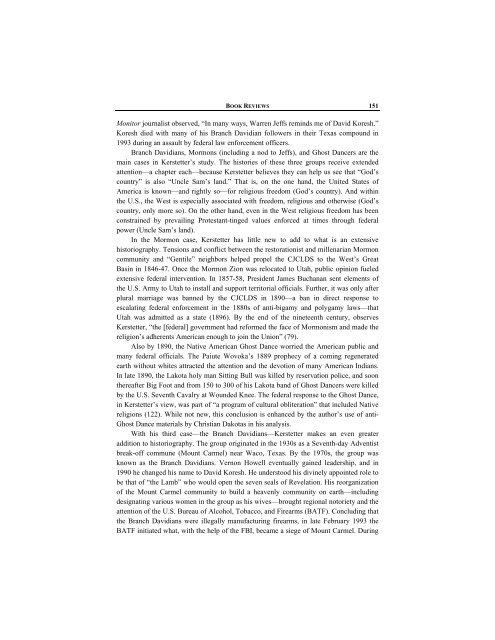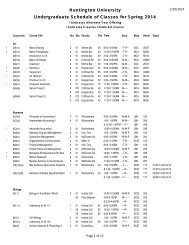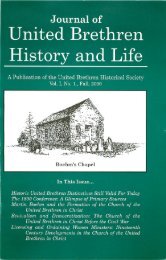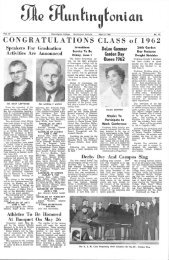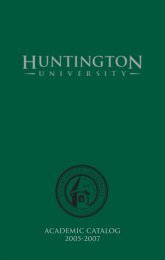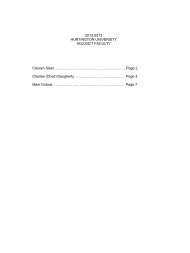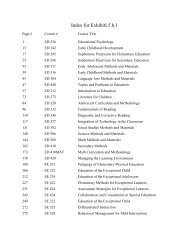Gillian Clark, Christianity and Roman Society - Huntington University
Gillian Clark, Christianity and Roman Society - Huntington University
Gillian Clark, Christianity and Roman Society - Huntington University
You also want an ePaper? Increase the reach of your titles
YUMPU automatically turns print PDFs into web optimized ePapers that Google loves.
BOOK REVIEWS 151<br />
Monitor journalist observed, “In many ways, Warren Jeffs reminds me of David Koresh.”<br />
Koresh died with many of his Branch Davidian followers in their Texas compound in<br />
1993 during an assault by federal law enforcement officers.<br />
Branch Davidians, Mormons (including a nod to Jeffs), <strong>and</strong> Ghost Dancers are the<br />
main cases in Kerstetter’s study. The histories of these three groups receive extended<br />
attention—a chapter each—because Kerstetter believes they can help us see that “God’s<br />
country” is also “Uncle Sam’s l<strong>and</strong>.” That is, on the one h<strong>and</strong>, the United States of<br />
America is known—<strong>and</strong> rightly so—for religious freedom (God’s country). And within<br />
the U.S., the West is especially associated with freedom, religious <strong>and</strong> otherwise (God’s<br />
country, only more so). On the other h<strong>and</strong>, even in the West religious freedom has been<br />
constrained by prevailing Protestant-tinged values enforced at times through federal<br />
power (Uncle Sam’s l<strong>and</strong>).<br />
In the Mormon case, Kerstetter has little new to add to what is an extensive<br />
historiography. Tensions <strong>and</strong> conflict between the restorationist <strong>and</strong> millenarian Mormon<br />
community <strong>and</strong> “Gentile” neighbors helped propel the CJCLDS to the West’s Great<br />
Basin in 1846-47. Once the Mormon Zion was relocated to Utah, public opinion fueled<br />
extensive federal intervention. In 1857-58, President James Buchanan sent elements of<br />
the U.S. Army to Utah to install <strong>and</strong> support territorial officials. Further, it was only after<br />
plural marriage was banned by the CJCLDS in 1890—a ban in direct response to<br />
escalating federal enforcement in the 1880s of anti-bigamy <strong>and</strong> polygamy laws—that<br />
Utah was admitted as a state (1896). By the end of the nineteenth century, observes<br />
Kerstetter, “the [federal] government had reformed the face of Mormonism <strong>and</strong> made the<br />
religion’s adherents American enough to join the Union” (79).<br />
Also by 1890, the Native American Ghost Dance worried the American public <strong>and</strong><br />
many federal officials. The Paiute Wovoka’s 1889 prophecy of a coming regenerated<br />
earth without whites attracted the attention <strong>and</strong> the devotion of many American Indians.<br />
In late 1890, the Lakota holy man Sitting Bull was killed by reservation police, <strong>and</strong> soon<br />
thereafter Big Foot <strong>and</strong> from 150 to 300 of his Lakota b<strong>and</strong> of Ghost Dancers were killed<br />
by the U.S. Seventh Cavalry at Wounded Knee. The federal response to the Ghost Dance,<br />
in Kerstetter’s view, was part of “a program of cultural obliteration” that included Native<br />
religions (122). While not new, this conclusion is enhanced by the author’s use of anti-<br />
Ghost Dance materials by Christian Dakotas in his analysis.<br />
With his third case—the Branch Davidians—Kerstetter makes an even greater<br />
addition to historiography. The group originated in the 1930s as a Seventh-day Adventist<br />
break-off commune (Mount Carmel) near Waco, Texas. By the 1970s, the group was<br />
known as the Branch Davidians. Vernon Howell eventually gained leadership, <strong>and</strong> in<br />
1990 he changed his name to David Koresh. He understood his divinely appointed role to<br />
be that of “the Lamb” who would open the seven seals of Revelation. His reorganization<br />
of the Mount Carmel community to build a heavenly community on earth—including<br />
designating various women in the group as his wives—brought regional notoriety <strong>and</strong> the<br />
attention of the U.S. Bureau of Alcohol, Tobacco, <strong>and</strong> Firearms (BATF). Concluding that<br />
the Branch Davidians were illegally manufacturing firearms, in late February 1993 the<br />
BATF initiated what, with the help of the FBI, became a siege of Mount Carmel. During


